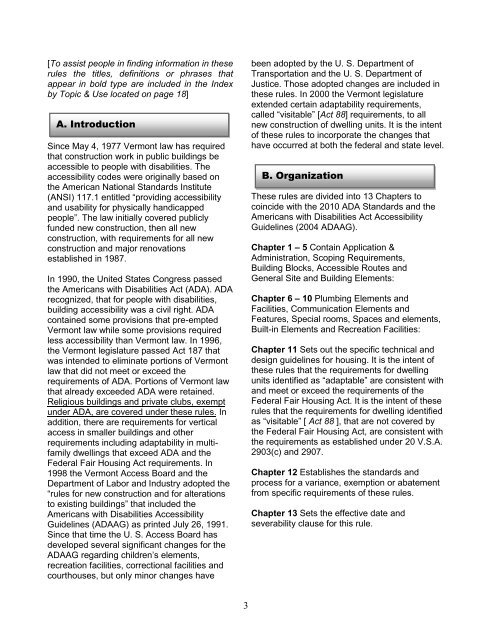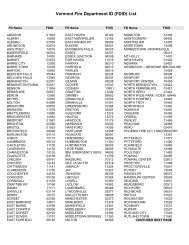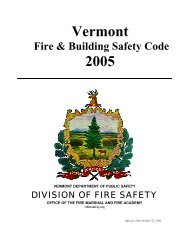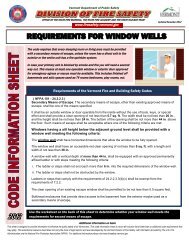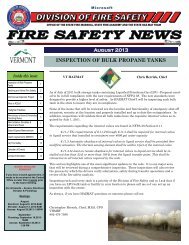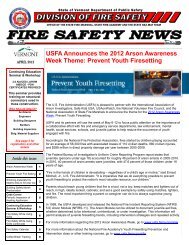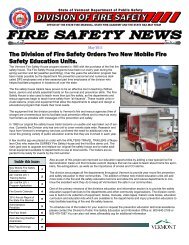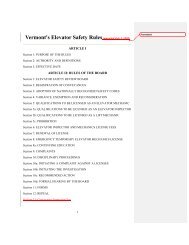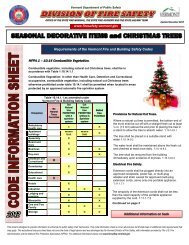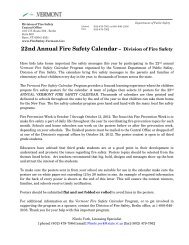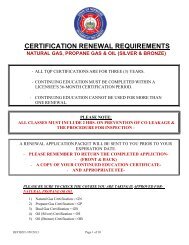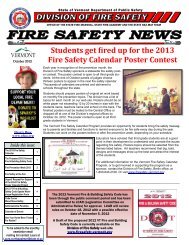Vermont Access Rules 2012 - - Vermont Division of Fire Safety
Vermont Access Rules 2012 - - Vermont Division of Fire Safety
Vermont Access Rules 2012 - - Vermont Division of Fire Safety
You also want an ePaper? Increase the reach of your titles
YUMPU automatically turns print PDFs into web optimized ePapers that Google loves.
[To assist people in finding information in theserules the titles, definitions or phrases thatappear in bold type are included in the Indexby Topic & Use located on page 18]A. IntroductionSince May 4, 1977 <strong>Vermont</strong> law has requiredthat construction work in public buildings beaccessible to people with disabilities. Theaccessibility codes were originally based onthe American National Standards Institute(ANSI) 117.1 entitled “providing accessibilityand usability for physically handicappedpeople”. The law initially covered publiclyfunded new construction, then all newconstruction, with requirements for all newconstruction and major renovationsestablished in 1987.In 1990, the United States Congress passedthe Americans with Disabilities Act (ADA). ADArecognized, that for people with disabilities,building accessibility was a civil right. ADAcontained some provisions that pre-empted<strong>Vermont</strong> law while some provisions requiredless accessibility than <strong>Vermont</strong> law. In 1996,the <strong>Vermont</strong> legislature passed Act 187 thatwas intended to eliminate portions <strong>of</strong> <strong>Vermont</strong>law that did not meet or exceed therequirements <strong>of</strong> ADA. Portions <strong>of</strong> <strong>Vermont</strong> lawthat already exceeded ADA were retained.Religious buildings and private clubs, exemptunder ADA, are covered under these rules. Inaddition, there are requirements for verticalaccess in smaller buildings and otherrequirements including adaptability in multifamilydwellings that exceed ADA and theFederal Fair Housing Act requirements. In1998 the <strong>Vermont</strong> <strong>Access</strong> Board and theDepartment <strong>of</strong> Labor and Industry adopted the“rules for new construction and for alterationsto existing buildings” that included theAmericans with Disabilities <strong>Access</strong>ibilityGuidelines (ADAAG) as printed July 26, 1991.Since that time the U. S. <strong>Access</strong> Board hasdeveloped several significant changes for theADAAG regarding children’s elements,recreation facilities, correctional facilities andcourthouses, but only minor changes havebeen adopted by the U. S. Department <strong>of</strong>Transportation and the U. S. Department <strong>of</strong>Justice. Those adopted changes are included inthese rules. In 2000 the <strong>Vermont</strong> legislatureextended certain adaptability requirements,called “visitable” [Act 88] requirements, to allnew construction <strong>of</strong> dwelling units. It is the intent<strong>of</strong> these rules to incorporate the changes thathave occurred at both the federal and state level.B. OrganizationThese rules are divided into 13 Chapters tocoincide with the 2010 ADA Standards and theAmericans with Disabilities Act <strong>Access</strong>ibilityGuidelines (2004 ADAAG).Chapter 1 – 5 Contain Application &Administration, Scoping Requirements,Building Blocks, <strong>Access</strong>ible Routes andGeneral Site and Building Elements:Chapter 6 – 10 Plumbing Elements andFacilities, Communication Elements andFeatures, Special rooms, Spaces and elements,Built-in Elements and Recreation Facilities:Chapter 11 Sets out the specific technical anddesign guidelines for housing. It is the intent <strong>of</strong>these rules that the requirements for dwellingunits identified as “adaptable” are consistent withand meet or exceed the requirements <strong>of</strong> theFederal Fair Housing Act. It is the intent <strong>of</strong> theserules that the requirements for dwelling identifiedas “visitable” [ Act 88 ], that are not covered bythe Federal Fair Housing Act, are consistent withthe requirements as established under 20 V.S.A.2903(c) and 2907.Chapter 12 Establishes the standards andprocess for a variance, exemption or abatementfrom specific requirements <strong>of</strong> these rules.Chapter 13 Sets the effective date andseverability clause for this rule.3


